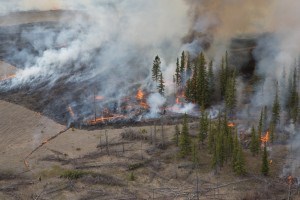
It was an eventful year for Jasper National Park’s Fire Management Team, dealing with 10 wildfires in the park and three prescribed burns.
Fire danger in the park was rated as ‘High’ or ‘Extreme’ for more than a third of May through August. The moisture content of deep, compact, organic layers in the floor of the forest was extremely low, meaning fires were likely to burn deep and be more difficult to extinguish.
The most significant wildfire that Jasper National Park responded to last summer was the Excelsior Wildfire in the Maligne Valley. A lightning strike on July 1, 2015 smouldered underground for nine days before coming to life on July 9, 2015. The wildfire was located along Medicine Lake, approximately 15 km southeast of the Town of Jasper.
The blaze resulted in more than 1,000 people being evacuated from both the front and backcountry of the Maligne Lake area. Fire specialists from national parks across the country, from PEI to the Gulf Islands, lent their expertise where needed. As many as 120 people worked on the ground in various capacities and together they brought the wildfire that encompassed 966 hectares or about 10 square kilometres under control in just over two weeks.
The Rockslide Creek Wildfire occurred in critical caribou habitat along the north edge of the park and in Willmore Wilderness Park. Parks Canada worked with the Province of Alberta to respond quickly. The efforts helped keep the flames contained to 12,052 hectares, most of which burned outside the park boundary. 

In addition to Jasper’s local wildfires, Jasper staff lent their expertise to other national parks during wildfire incidents and prescribed fires in the Northwest Territories, Saskatchewan, Newfoundland and Alberta.
Last fire season, Parks Canada conducted several prescribed fires across Jasper National Park. Prescribed fires are designed to reintroduce an important natural process which renews and regenerates our landscapes. 
 In the spring of 2015, the Jasper Fire Management Team burned the last 500 hectares planned in the Vine Creek area, about 20 km north of the Town of Jasper on the slopes of Mt. Greenock. The targeted burning in this location has helped create a strategic break for wildfires and mountain pine beetle, encourages whitebark pine colonization (a species at risk); and helps restore Douglas fir savannah.
Also in the spring of 2015, the team burned 111 hectares in the Jackladder Complex, 15 km north of the town, at the airstrip. Later in the year, the team built fireguards that will act as barriers to prevent fire from spreading when they conduct a follow-up prescribed burn in the area south of the airstrip when conditions are right in 2016. These burns will help restore open valley bottom grasslands that were historically present.
Twelve Aboriginal youth with historical ties to Jasper National Park took part in Jasper’s Basic Fire Management program. After taking the course, they helped carry out a seven hectare prescribed fire about 20 km north of Jasper along the Snaring Road. Prescribed fires in the Snaring Complex emulate the spring burning carried out by Aboriginal peoples in the early 1900s, helping to bring the Indigenous youth back in touch with their own heritage.
As weather and forest conditions allow, the burns for this year may include:
- Completing another unit of the Jackladder Complex (14 km north of the Jasper townsite)
- Maintaining the community fireguard up-wind of the townsite
- Continuation of work in the Fiddle Complex (300 hectares that span the Athabasca Valley along the park’s east boundary)
- Completing work in the Snaring Complex (20 km from Jasper)
- Preparing for the Bench Lakes Complex of prescribed fires (a 420 hectare area west of the townsite)
Parks Canada is a world leader with more than 30 years of experience in using fire to naturally restore and maintain the ecological integrity of national parks and historic sites. Fire is a natural process and a crucial part of a healthy ecosystem.
Through safe and effective fire management, we are improving the ecological health of Jasper’s forests and grasslands, while reducing the danger of wildfire to the public, infrastructure and neighbouring lands.
The safety of the public, our crews, park infrastructure, and neighbouring lands is always our number one priority.
Parks Canada
Special to the 51°µÍø
